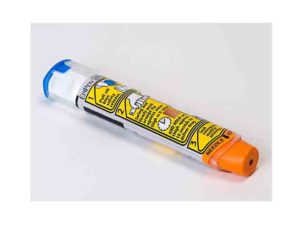Anaphylaxis Diagnosis may sometimes be difficult
Anaphylaxis Diagnosis
Diagnostic Criteria for Anaphylaxis
Following are the diagnostic points:
-
Acute illness ( within minutes to hours) involving skin, mucosal tissues or both , and at least one of the following:
- Respiratory compromise. Features of respiratory comprise include dyspnea, bronchospasm, stridor, hypoxemia etc)
- Reduced blood pressure or associated symptoms of end-organ dysfunction. Features include hypotonia, syncope, collapse etc
-
Two or more of the following that occur rapidly after exposure to a likely allergen:
- Skin-mucosal tissue involvement. Signs include generalized hives, itch-flush, swollen lips-tongue-uvula.
- Respiratory compromise. Signs include dyspnea, bronchospasm, stridor, hypoxemia.
- Reduced blood pressure or associated symptoms of end-organ dysfunction. Sign include hypotonia, syncope, collapse.
- Persistent gastrointestinal symptoms. Sign include painful abdominal cramps, vomiting
-
Reduced blood pressure after exposure to a known allergen:
For Infants and children: Low systolic BP (age-specific) or greater than 30% decrease in systolic BP
For Adults: Systolic BP of less than 90mmHg or greater than 30% from that
person’s baseline
Investigations include
- Serum tryptase level
- in vitro IgE testing
- Skin test
- Challenge test
- Basophil activation test
Treatment of Anaphylaxis
If someone has symptoms of anaphylaxis, you should:
- Use an adrenaline/epinephrine auto-injector. Give another adrenaline injection after 5-15 minutes if the symptoms don’t improve and a second auto-injector is available
Dose of Adrenaline / Epinephrine
10-20 kg (~1-5yrs) – 0.15mg (green labelled on autoinjector)
>20kg (~>5yrs) – 0.3mg (yellow labelled on autoinjector)
Pregnant woman- 0.3mg (yellow labelled on autoinjector)
If do not have autoinjector or in hospital settings
Give INTRAMUSCULAR (IM) injection of Adrenaline/ Epinephrine as follows:
- 1:1000 solution of Adrenaline in IM into outer aspect of mid-thigh in right site.
- 0.01mg per kg up to maximum of 0.5mg per dose can be used.
- Repeat every 5 minutes as needed.
- Call emergency number for an ambulance immediately
- Remove any trigger if possible – for example, carefully remove any wasp or bee sting stuck in the skin
- Lie the person down flat. The left lateral position is recommended for patients who are pregnant.




